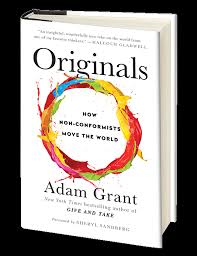How do you keep readers reading? How do you pull them through a chapter or article or blog without them getting bored or distracted?
Fiction writers aren’t the only ones who can use a mystery to keep readers engaged. Nonfiction writers can also withhold a key piece of information—the whodunnit! It’s what I call the Big Reveal in Write Better. How does it work?
 Adam Grant uses the technique effectively in his book Originals. At the beginning of chapter two Grant tells of “an invention [that] took Silicon Valley by storm.” Steve Jobs offered $63 million for 10 percent of the company and the inventor turned it down. But Jobs was so enamored “he offered to advise the inventor for the next six months—for free.”
Adam Grant uses the technique effectively in his book Originals. At the beginning of chapter two Grant tells of “an invention [that] took Silicon Valley by storm.” Steve Jobs offered $63 million for 10 percent of the company and the inventor turned it down. But Jobs was so enamored “he offered to advise the inventor for the next six months—for free.”
Legendary investor John Doerr pumped in $80 million, thought it would be the fastest company to reach $1 billion, and “would become more important than the internet.”
“The inventor himself was described as a modern Thomas Edison—he already had a track record of remarkable breakthroughs” which Grant details. The inventor thought he’d soon be selling 10,000 units a week but six years after launch they had only sold 30,000 total.
The product? The Segway, one of the most hyped tech devices in decades with the most disappointing results.
Grant immediately tells us another tale in the same vein. Two entertainers with no TV writing experience struggle to put together a half-hour sitcom pilot. The test audience in Los Angeles gave it bland to bad marks. Somehow, though, the pilot was aired—to yawns. But a passionate exec ordered a few more episodes against the wisdom of others despite the fact that one of the writers said he’d run out of ideas and was ready to quit. Over the next decade, it became the most popular show in America.
“If you’ve ever complained about a close talker, accused a partygoer of double-dipping a chip, uttered the disclaimer ‘Not that there’s anything wrong with that,’ or rejected someone by saying ‘No soup for you,’ you’re using phrases coined” on Seinfeld.
 Grant hooks us by putting two mysteries in front of us which we actively try to solve ourselves before the author reveals the answers. But he doesn’t stop there.
Grant hooks us by putting two mysteries in front of us which we actively try to solve ourselves before the author reveals the answers. But he doesn’t stop there.
The author then asks, How can our predictions about innovations go so wrong—sometimes predicting a hit that becomes a flop, and other times forecasting a bomb that becomes a sensation? He outlines what’s ahead—again without giving away the solution. We’ll discover “best practices in idea selection . . . how to make fewer bad bets . . . meet two venture capitalists who anticipated the failure of the Segway . . . see why it’s so difficult for managers and test audiences to accurately evaluate new ideas,” and more.
If we want to find out about all these interesting results, we’ll have to read on. I did.
photo: Pixabay talliev
